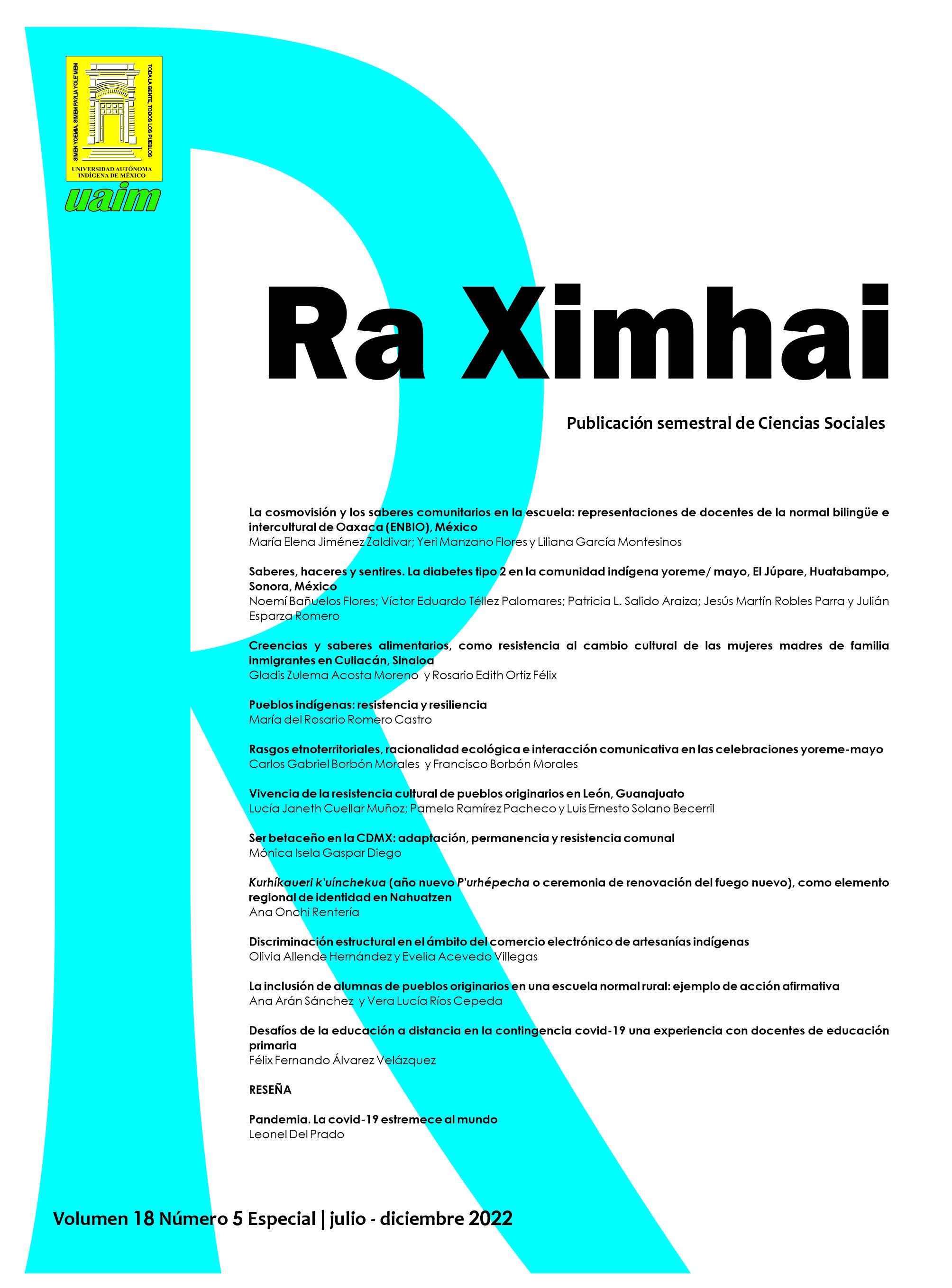Kurhíkaueri k’uínchekua (P’urhépecha new year or new fire renewal ceremony), as a regional element of identity in Nahuatzen
DOI:
https://doi.org/10.35197/rx.18.05.2022.08.aoKeywords:
new year, flag, mother tongue, indigenous deities and identityAbstract
As is known, Mexico is a multicultural country due to its great cultural and linguistic diversity that unfolds throughout its territory. This article aims to show and argue the cultural and ethnic importance of the celebration of the p'urhépecha New Year. Festival that takes place annually in a mobile way in some community of the four p'urhépecha regions: the lake, the ravine of the eleven towns, the sierra region and the Zacapu swamp, in the state of Michoacán de Ocampo. The p'urhépecha express their struggle and cultural resistance through this historical event that revolves around developing rituals that help to claim the past with the ancestral present that is based on their philosophy and cultural history, in which an arduous reflection through questioning the sense and meaning of being p'urhépecha even in a monolingual community (such as Nahuatzen) nestled in the p'urhépecha plateau that during the months of December and January delights with its surprising landscapes that can be glimpsed in the community where the red tile roofs are covered with ice and when the first rays of the sun heat up they slide into soft drops of water that fall on the earth from which a soft aroma without equal is released and the song of the birds announces the revival awakening of the Nahuatzenses.
Downloads
References
Bernard, H. (1994). Research methods in anthropology: qualitative and quantitative approaches (segunda edición) Walnut Creek, CA: Alta Mira Press.
Camacho, A. (2014). Kurhikuaeri K’uinchekua: La performance itinerante. [Tesis de licenciatura en Lengua y Comunicación Intercultural, Universidad Intercultural Indígena de Michoacán].
Díaz, E. (1983). “La región de Uruapan: Criterios de definición y características ecológicas”. En: Relaciones, núm. 14, pp. 5-30.
Dietz, G. (1999). La comunidad purhépecha es nuestra fuerza. Etnicidad, cultura y región en un movimiento indígena de México. Quito: Abya Yala.
De la Peña, G. (2002). “La institución municipal contra las instituciones indígenas: comentario”, en El municipio en México (Brigitte Boehm de Lameiras, coord.), Zamora, El Colegio de Michoacán, pp. 294-295.
Dora, N. (2019). El año Nuevo Purépecha. Michoacán: Sinapsis.
Gouy-Gilbert, C. (1987). “Ocumicho y Patamban: dos maneras de ser artesano”. En: Cuadernos de Estudios Michoacanos, vol. 2, pp. 8-10.
Giménez, G. (2000). “Territorio, cultura e identidades. La región sociocultural”. En: Rocío Rosales Ortega (coord.), Globalización y regiones en México. México: Porrúa, pp. 19-52.
Hall, S. y Gay, P. (2003). Cuestiones de identidad cultural. Buenos Aires: Amorrortu Editores.
Ojeda, L. (2006). Fiestas y ceremonias tradicionales p’urhepechas. Morelia: Secretaría de Cultura de Michoacán.
Páez, I. (1985). La enseñanza de la lengua materna: hacia un programa comunicacional integral. Instituto Universitario Pedagógico de Caracas.
Toledo, V. y N. Barrera-Bassols. (2008). La Memoria Biocultural: la importancia ecológica de las sabidurías tradicionales. Icaria Editorial. Barcelona.
Zárate, J. (1994). “La fiesta del año nuevo p’urhépecha como ritual político. Notas en torno al discurso de los profesionales indígenas p’urhépechas”. En: Roth, Andrew y Lameiras, J. (eds.), El verbo oficial: Política moderna en dos campos periféricos del estado mexicano. Zamora: El Colegio de Michoacán-Universidad ITESO, pp.99-124.
Villoro, L. (2014). Los grandes momentos del indigenismo en México, México: Fondo de Cultura Económica.
Downloads
Published
How to Cite
Issue
Section
License
Copyright (c) 2022 Ana Onchi Renteria

This work is licensed under a Creative Commons Attribution-NonCommercial 4.0 International License.
Usted es libre de:
- Compartir — copiar y redistribuir el material en cualquier medio o formato
- Adaptar — remezclar, transformar y construir a partir del material
- La licenciante no puede revocar estas libertades en tanto usted siga los términos de la licencia
Bajo los siguientes términos:
- Atribución — Usted debe dar crédito de manera adecuada , brindar un enlace a la licencia, e indicar si se han realizado cambios . Puede hacerlo en cualquier forma razonable, pero no de forma tal que sugiera que usted o su uso tienen el apoyo de la licenciante.
- NoComercial — Usted no puede hacer uso del material con propósitos comerciales .
- No hay restricciones adicionales — No puede aplicar términos legales ni medidas tecnológicas que restrinjan legalmente a otras a hacer cualquier uso permitido por la licencia.








